Financial Management: Equity Finance and Investment Appraisal
VerifiedAdded on 2024/06/07
|14
|3032
|141
Report
AI Summary
This report provides a detailed analysis of equity finance and investment appraisal techniques. It begins by examining equity finance, including the number of shares to be issued, theoretical ex-right price, and earnings per share under different right issue scenarios. It then discusses the advantages for both companies and shareholders of using scrip dividends. The report also evaluates investment appraisal techniques such as the payback period, accounting rate of return (ARR), net present value (NPV), and internal rate of return (IRR), providing calculations and interpretations for each. Finally, it critically evaluates the benefits and limitations of each investment appraisal technique, supported by relevant academic research, offering a comprehensive overview of financial management strategies.
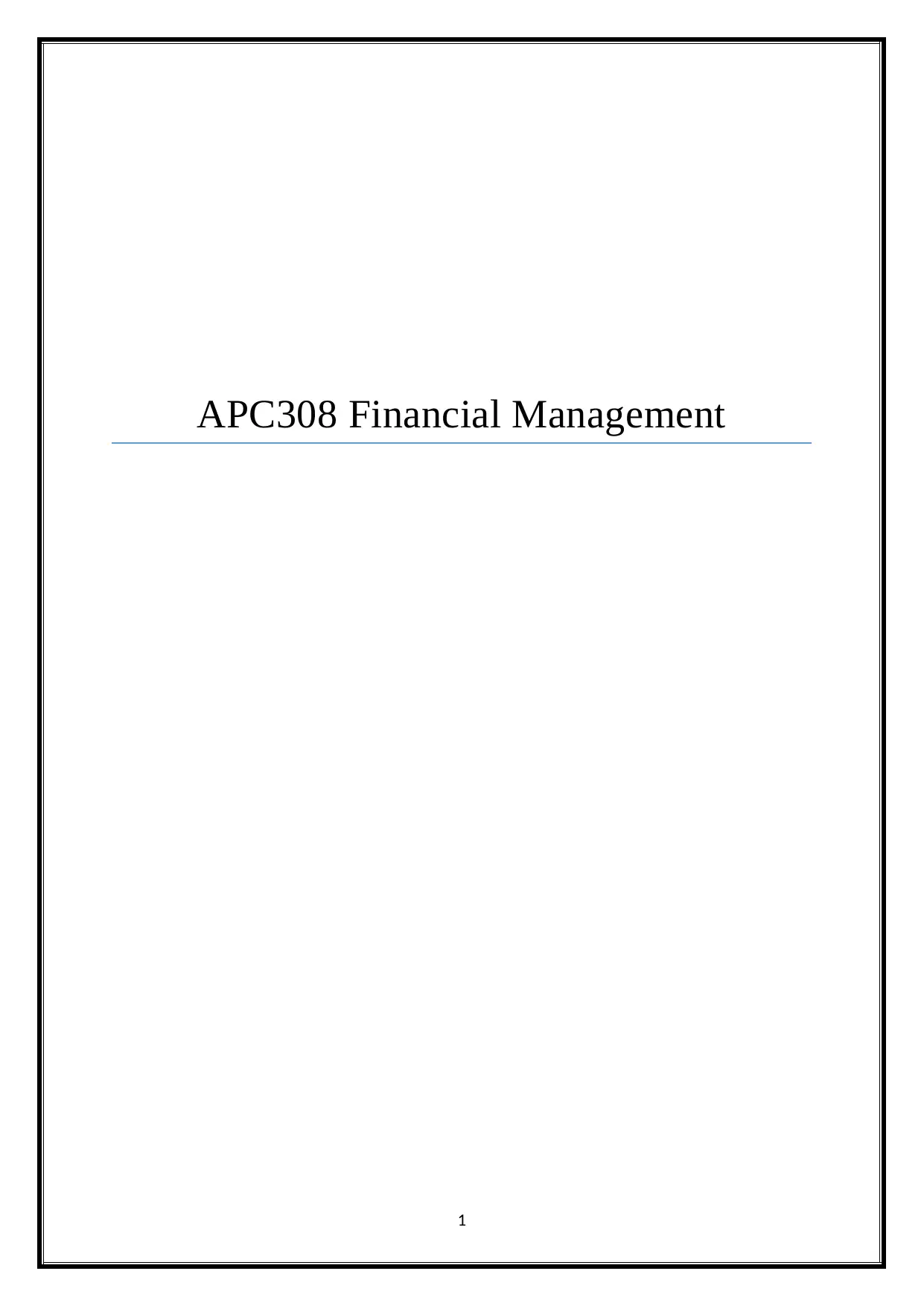
APC308 Financial Management
1
1
Paraphrase This Document
Need a fresh take? Get an instant paraphrase of this document with our AI Paraphraser
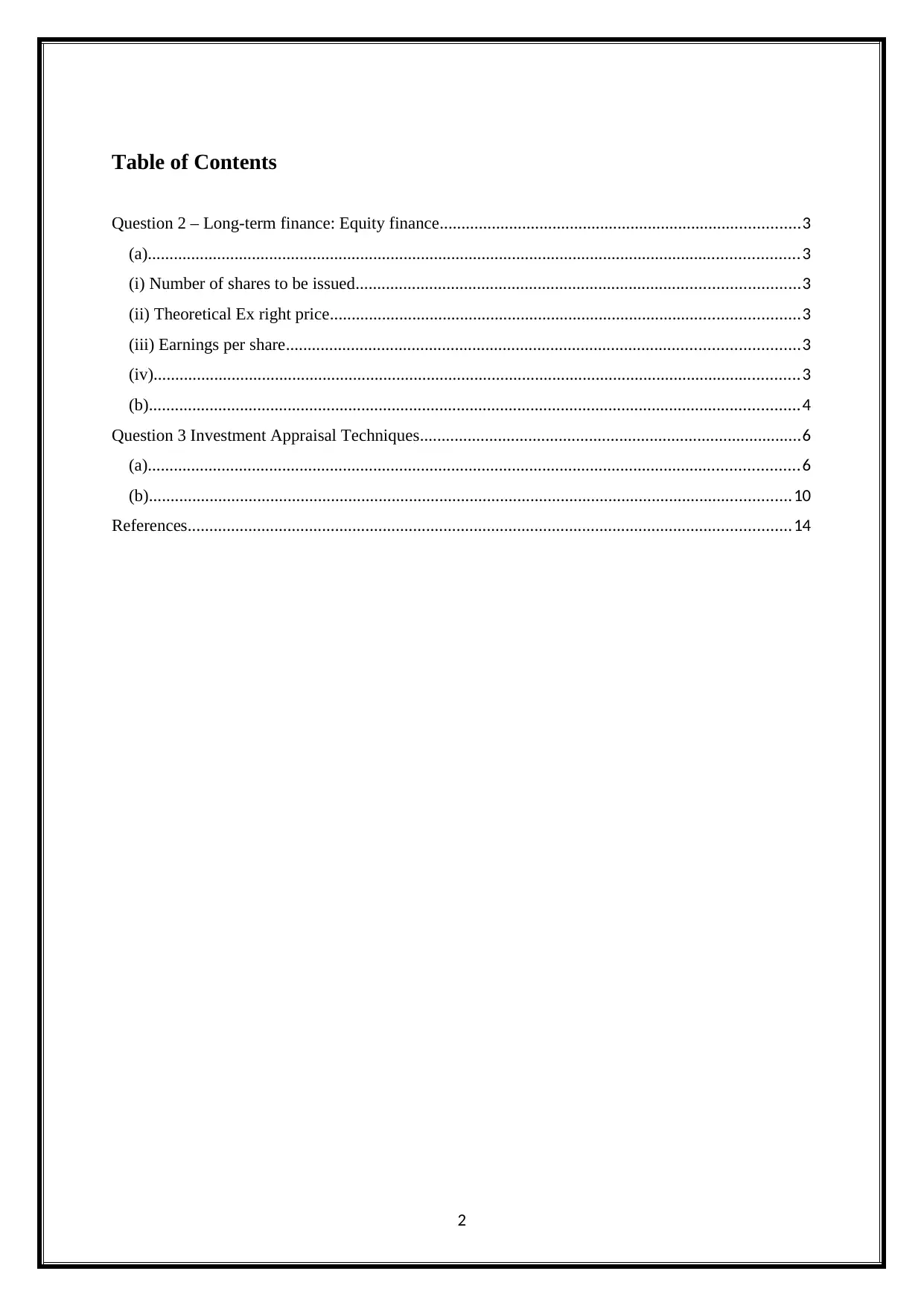
Table of Contents
Question 2 – Long-term finance: Equity finance...................................................................................3
(a)......................................................................................................................................................3
(i) Number of shares to be issued......................................................................................................3
(ii) Theoretical Ex right price............................................................................................................3
(iii) Earnings per share......................................................................................................................3
(iv).....................................................................................................................................................3
(b)......................................................................................................................................................4
Question 3 Investment Appraisal Techniques........................................................................................6
(a)......................................................................................................................................................6
(b)....................................................................................................................................................10
References...........................................................................................................................................14
2
Question 2 – Long-term finance: Equity finance...................................................................................3
(a)......................................................................................................................................................3
(i) Number of shares to be issued......................................................................................................3
(ii) Theoretical Ex right price............................................................................................................3
(iii) Earnings per share......................................................................................................................3
(iv).....................................................................................................................................................3
(b)......................................................................................................................................................4
Question 3 Investment Appraisal Techniques........................................................................................6
(a)......................................................................................................................................................6
(b)....................................................................................................................................................10
References...........................................................................................................................................14
2
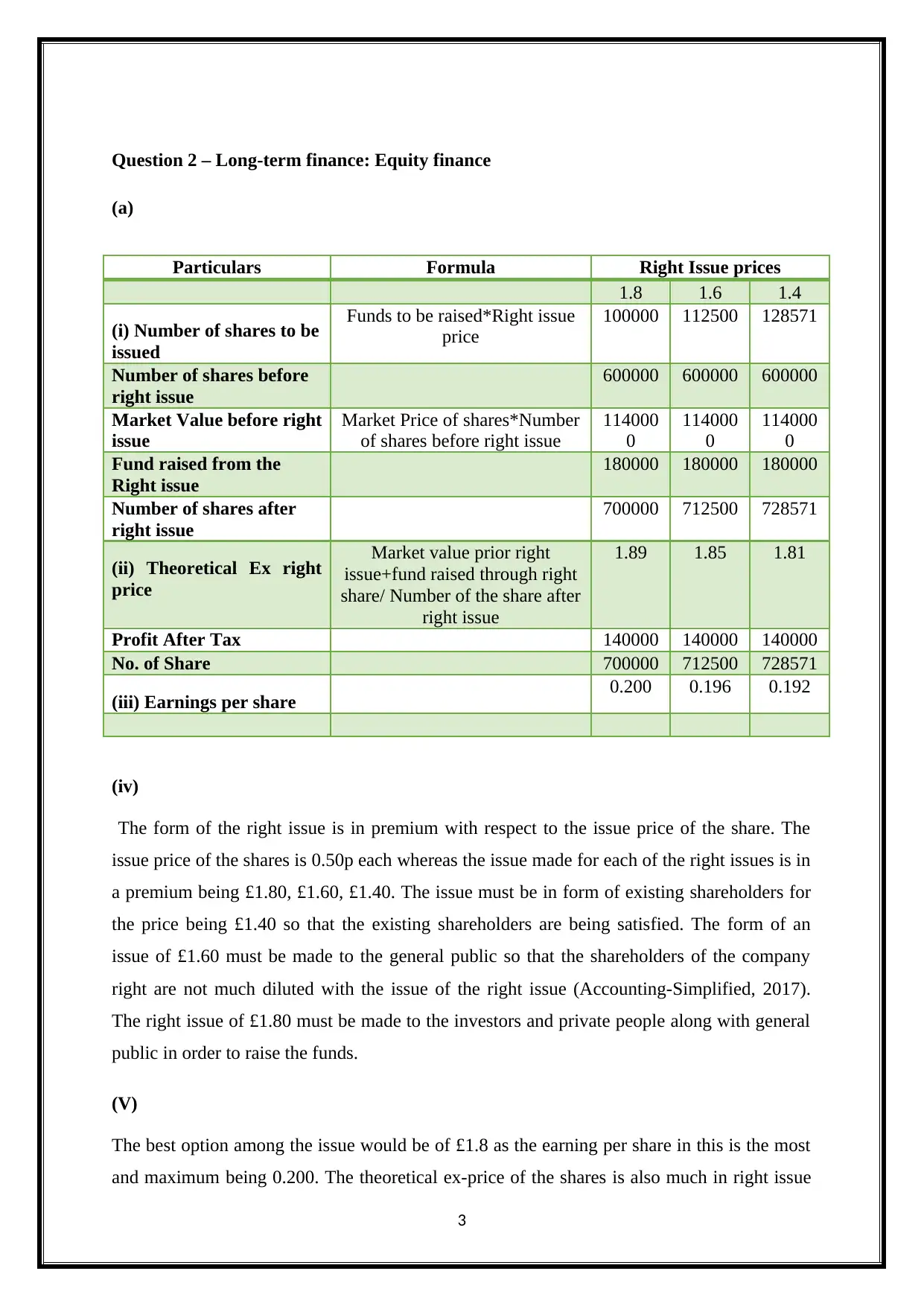
Question 2 – Long-term finance: Equity finance
(a)
Particulars Formula Right Issue prices
1.8 1.6 1.4
(i) Number of shares to be
issued
Funds to be raised*Right issue
price
100000 112500 128571
Number of shares before
right issue
600000 600000 600000
Market Value before right
issue
Market Price of shares*Number
of shares before right issue
114000
0
114000
0
114000
0
Fund raised from the
Right issue
180000 180000 180000
Number of shares after
right issue
700000 712500 728571
(ii) Theoretical Ex right
price
Market value prior right
issue+fund raised through right
share/ Number of the share after
right issue
1.89 1.85 1.81
Profit After Tax 140000 140000 140000
No. of Share 700000 712500 728571
(iii) Earnings per share 0.200 0.196 0.192
(iv)
The form of the right issue is in premium with respect to the issue price of the share. The
issue price of the shares is 0.50p each whereas the issue made for each of the right issues is in
a premium being £1.80, £1.60, £1.40. The issue must be in form of existing shareholders for
the price being £1.40 so that the existing shareholders are being satisfied. The form of an
issue of £1.60 must be made to the general public so that the shareholders of the company
right are not much diluted with the issue of the right issue (Accounting-Simplified, 2017).
The right issue of £1.80 must be made to the investors and private people along with general
public in order to raise the funds.
(V)
The best option among the issue would be of £1.8 as the earning per share in this is the most
and maximum being 0.200. The theoretical ex-price of the shares is also much in right issue
3
(a)
Particulars Formula Right Issue prices
1.8 1.6 1.4
(i) Number of shares to be
issued
Funds to be raised*Right issue
price
100000 112500 128571
Number of shares before
right issue
600000 600000 600000
Market Value before right
issue
Market Price of shares*Number
of shares before right issue
114000
0
114000
0
114000
0
Fund raised from the
Right issue
180000 180000 180000
Number of shares after
right issue
700000 712500 728571
(ii) Theoretical Ex right
price
Market value prior right
issue+fund raised through right
share/ Number of the share after
right issue
1.89 1.85 1.81
Profit After Tax 140000 140000 140000
No. of Share 700000 712500 728571
(iii) Earnings per share 0.200 0.196 0.192
(iv)
The form of the right issue is in premium with respect to the issue price of the share. The
issue price of the shares is 0.50p each whereas the issue made for each of the right issues is in
a premium being £1.80, £1.60, £1.40. The issue must be in form of existing shareholders for
the price being £1.40 so that the existing shareholders are being satisfied. The form of an
issue of £1.60 must be made to the general public so that the shareholders of the company
right are not much diluted with the issue of the right issue (Accounting-Simplified, 2017).
The right issue of £1.80 must be made to the investors and private people along with general
public in order to raise the funds.
(V)
The best option among the issue would be of £1.8 as the earning per share in this is the most
and maximum being 0.200. The theoretical ex-price of the shares is also much in right issue
3
⊘ This is a preview!⊘
Do you want full access?
Subscribe today to unlock all pages.

Trusted by 1+ million students worldwide
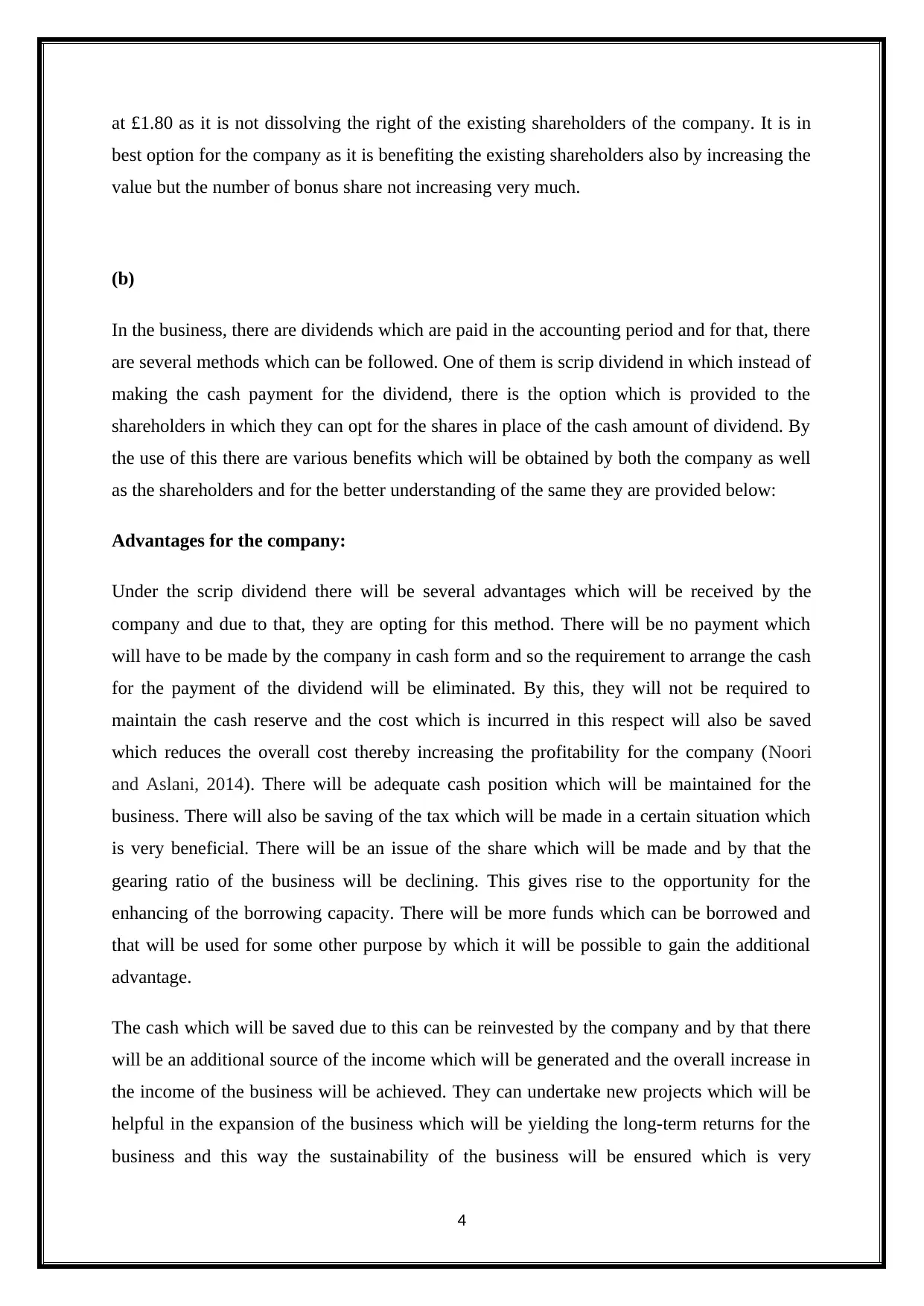
at £1.80 as it is not dissolving the right of the existing shareholders of the company. It is in
best option for the company as it is benefiting the existing shareholders also by increasing the
value but the number of bonus share not increasing very much.
(b)
In the business, there are dividends which are paid in the accounting period and for that, there
are several methods which can be followed. One of them is scrip dividend in which instead of
making the cash payment for the dividend, there is the option which is provided to the
shareholders in which they can opt for the shares in place of the cash amount of dividend. By
the use of this there are various benefits which will be obtained by both the company as well
as the shareholders and for the better understanding of the same they are provided below:
Advantages for the company:
Under the scrip dividend there will be several advantages which will be received by the
company and due to that, they are opting for this method. There will be no payment which
will have to be made by the company in cash form and so the requirement to arrange the cash
for the payment of the dividend will be eliminated. By this, they will not be required to
maintain the cash reserve and the cost which is incurred in this respect will also be saved
which reduces the overall cost thereby increasing the profitability for the company (Noori
and Aslani, 2014). There will be adequate cash position which will be maintained for the
business. There will also be saving of the tax which will be made in a certain situation which
is very beneficial. There will be an issue of the share which will be made and by that the
gearing ratio of the business will be declining. This gives rise to the opportunity for the
enhancing of the borrowing capacity. There will be more funds which can be borrowed and
that will be used for some other purpose by which it will be possible to gain the additional
advantage.
The cash which will be saved due to this can be reinvested by the company and by that there
will be an additional source of the income which will be generated and the overall increase in
the income of the business will be achieved. They can undertake new projects which will be
helpful in the expansion of the business which will be yielding the long-term returns for the
business and this way the sustainability of the business will be ensured which is very
4
best option for the company as it is benefiting the existing shareholders also by increasing the
value but the number of bonus share not increasing very much.
(b)
In the business, there are dividends which are paid in the accounting period and for that, there
are several methods which can be followed. One of them is scrip dividend in which instead of
making the cash payment for the dividend, there is the option which is provided to the
shareholders in which they can opt for the shares in place of the cash amount of dividend. By
the use of this there are various benefits which will be obtained by both the company as well
as the shareholders and for the better understanding of the same they are provided below:
Advantages for the company:
Under the scrip dividend there will be several advantages which will be received by the
company and due to that, they are opting for this method. There will be no payment which
will have to be made by the company in cash form and so the requirement to arrange the cash
for the payment of the dividend will be eliminated. By this, they will not be required to
maintain the cash reserve and the cost which is incurred in this respect will also be saved
which reduces the overall cost thereby increasing the profitability for the company (Noori
and Aslani, 2014). There will be adequate cash position which will be maintained for the
business. There will also be saving of the tax which will be made in a certain situation which
is very beneficial. There will be an issue of the share which will be made and by that the
gearing ratio of the business will be declining. This gives rise to the opportunity for the
enhancing of the borrowing capacity. There will be more funds which can be borrowed and
that will be used for some other purpose by which it will be possible to gain the additional
advantage.
The cash which will be saved due to this can be reinvested by the company and by that there
will be an additional source of the income which will be generated and the overall increase in
the income of the business will be achieved. They can undertake new projects which will be
helpful in the expansion of the business which will be yielding the long-term returns for the
business and this way the sustainability of the business will be ensured which is very
4
Paraphrase This Document
Need a fresh take? Get an instant paraphrase of this document with our AI Paraphraser

important. The share price will also not be diluted with the help of this as there will be an
issue which will be made and the decline will be there only in some of the significant cases.
Overall it can be said that company is taking the proper decision by using this mode of
making the dividend distribution.
Advantages for the shareholders:
The issues which are made under the scrip dividend are also beneficial for the shareholders in
many ways. As there will be no cash which will be received by them and only the shares will
be allotted to them so by this they will be able to make the saving of the tax as there will be
various tax benefits which will be obtained by them. There are several investors who want to
increase their holding in the company and for that, they are required to make the purchase of
the shares (Wesson, 2015). But they are not able to do so due to lack of the funds. In this
case, they will be allotted the shares and there will be no cost which will have to be incurred
by them in this respect. So it can be said that they will be able to increase their holding in the
business without being required to make any kind of expenditure. There will be a rise in their
share and they will be more important now for the company.
This will also develop the interest of the investors as they will be keen on receiving the new
shares which will be making the growth possible for them. There will be no cash which will
be received by them but in place of that shares will be obtained which will be more beneficial
for them as this will be providing them with the long-term advantages in the company and
they will be able to maintain their position in the business for long.
All of this is the part of the financial management which will be made and will be undertaken
in such manner that the benefit will be long lasting and will be increasing the value of the
business and also a number of investors will be attracted who will be interested in making the
investment in the company.
5
issue which will be made and the decline will be there only in some of the significant cases.
Overall it can be said that company is taking the proper decision by using this mode of
making the dividend distribution.
Advantages for the shareholders:
The issues which are made under the scrip dividend are also beneficial for the shareholders in
many ways. As there will be no cash which will be received by them and only the shares will
be allotted to them so by this they will be able to make the saving of the tax as there will be
various tax benefits which will be obtained by them. There are several investors who want to
increase their holding in the company and for that, they are required to make the purchase of
the shares (Wesson, 2015). But they are not able to do so due to lack of the funds. In this
case, they will be allotted the shares and there will be no cost which will have to be incurred
by them in this respect. So it can be said that they will be able to increase their holding in the
business without being required to make any kind of expenditure. There will be a rise in their
share and they will be more important now for the company.
This will also develop the interest of the investors as they will be keen on receiving the new
shares which will be making the growth possible for them. There will be no cash which will
be received by them but in place of that shares will be obtained which will be more beneficial
for them as this will be providing them with the long-term advantages in the company and
they will be able to maintain their position in the business for long.
All of this is the part of the financial management which will be made and will be undertaken
in such manner that the benefit will be long lasting and will be increasing the value of the
business and also a number of investors will be attracted who will be interested in making the
investment in the company.
5
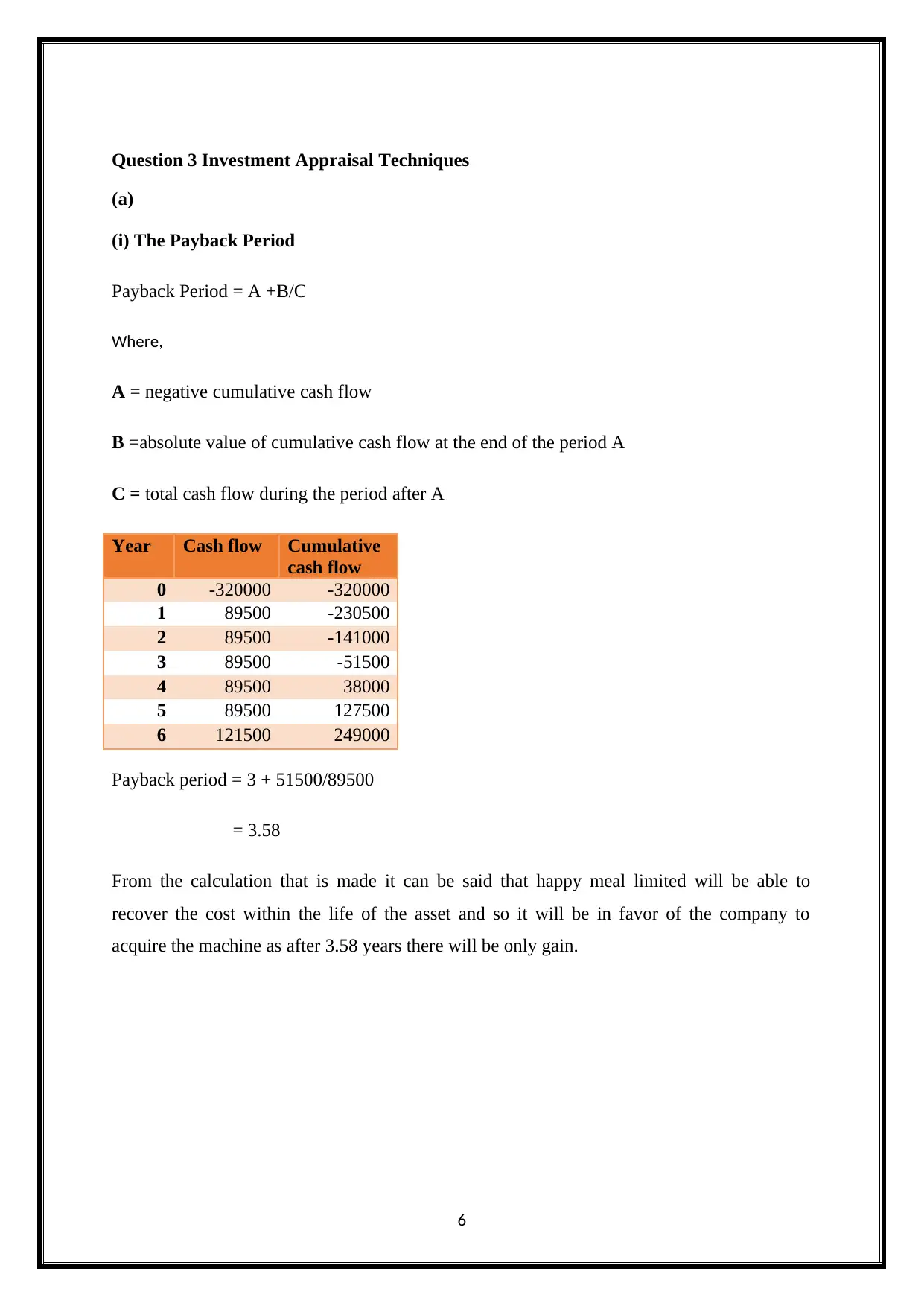
Question 3 Investment Appraisal Techniques
(a)
(i) The Payback Period
Payback Period = A +B/C
Where,
A = negative cumulative cash flow
B =absolute value of cumulative cash flow at the end of the period A
C = total cash flow during the period after A
Year Cash flow Cumulative
cash flow
0 -320000 -320000
1 89500 -230500
2 89500 -141000
3 89500 -51500
4 89500 38000
5 89500 127500
6 121500 249000
Payback period = 3 + 51500/89500
= 3.58
From the calculation that is made it can be said that happy meal limited will be able to
recover the cost within the life of the asset and so it will be in favor of the company to
acquire the machine as after 3.58 years there will be only gain.
6
(a)
(i) The Payback Period
Payback Period = A +B/C
Where,
A = negative cumulative cash flow
B =absolute value of cumulative cash flow at the end of the period A
C = total cash flow during the period after A
Year Cash flow Cumulative
cash flow
0 -320000 -320000
1 89500 -230500
2 89500 -141000
3 89500 -51500
4 89500 38000
5 89500 127500
6 121500 249000
Payback period = 3 + 51500/89500
= 3.58
From the calculation that is made it can be said that happy meal limited will be able to
recover the cost within the life of the asset and so it will be in favor of the company to
acquire the machine as after 3.58 years there will be only gain.
6
⊘ This is a preview!⊘
Do you want full access?
Subscribe today to unlock all pages.

Trusted by 1+ million students worldwide
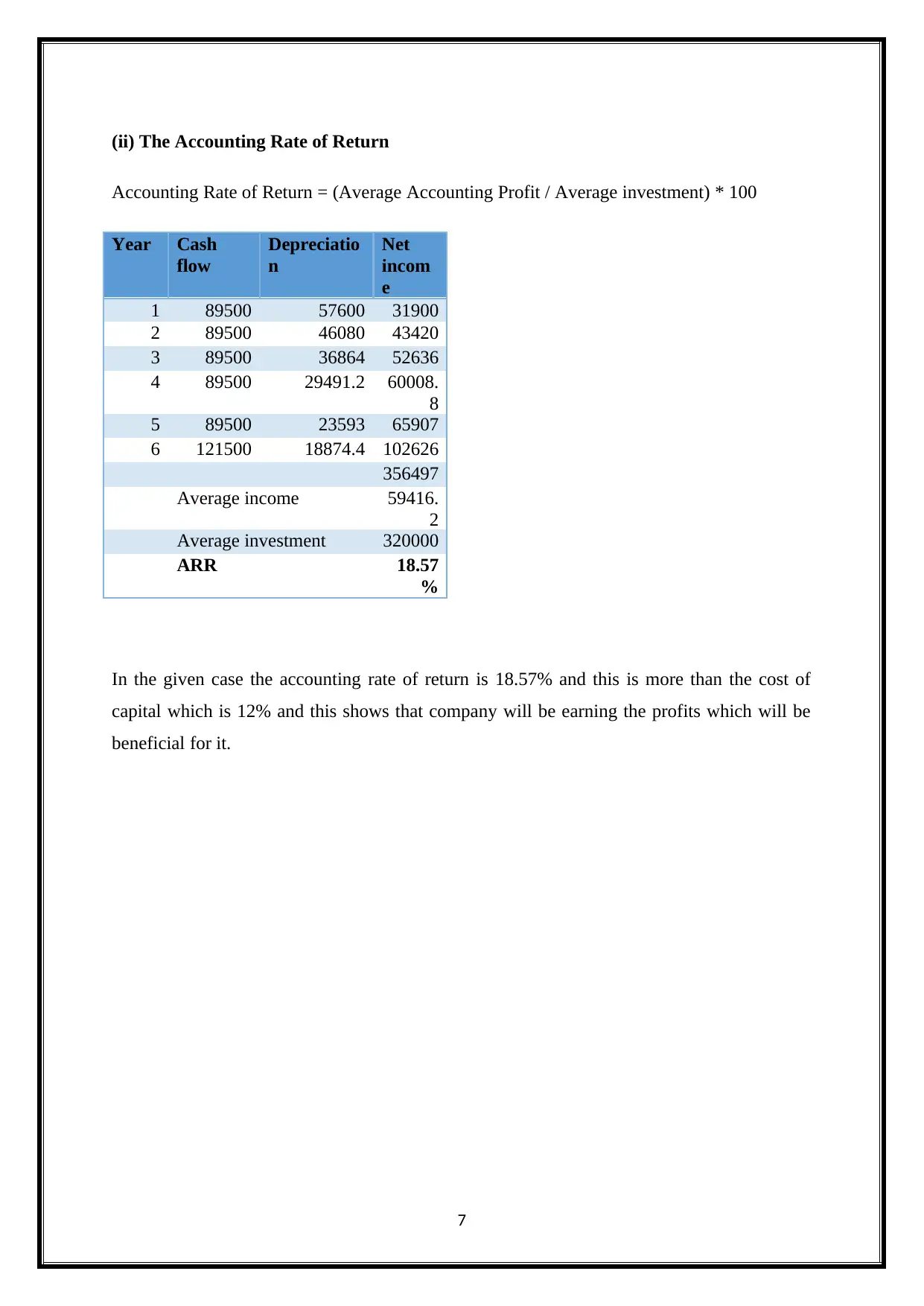
(ii) The Accounting Rate of Return
Accounting Rate of Return = (Average Accounting Profit / Average investment) * 100
Year Cash
flow
Depreciatio
n
Net
incom
e
1 89500 57600 31900
2 89500 46080 43420
3 89500 36864 52636
4 89500 29491.2 60008.
8
5 89500 23593 65907
6 121500 18874.4 102626
356497
Average income 59416.
2
Average investment 320000
ARR 18.57
%
In the given case the accounting rate of return is 18.57% and this is more than the cost of
capital which is 12% and this shows that company will be earning the profits which will be
beneficial for it.
7
Accounting Rate of Return = (Average Accounting Profit / Average investment) * 100
Year Cash
flow
Depreciatio
n
Net
incom
e
1 89500 57600 31900
2 89500 46080 43420
3 89500 36864 52636
4 89500 29491.2 60008.
8
5 89500 23593 65907
6 121500 18874.4 102626
356497
Average income 59416.
2
Average investment 320000
ARR 18.57
%
In the given case the accounting rate of return is 18.57% and this is more than the cost of
capital which is 12% and this shows that company will be earning the profits which will be
beneficial for it.
7
Paraphrase This Document
Need a fresh take? Get an instant paraphrase of this document with our AI Paraphraser

(iii) The Net Present Value
Net Present Value = Present value of inflows-present value of outflows
Year Cash flow PVF @12% PV @
12%
0 -320000 1 -320000
1 89500 0.89286 79910.7
2 89500 0.79719 71348.9
3 89500 0.71178 63704.3
4 89500 0.63552 56878.9
5 89500 0.56743 50784.7
6 121500 0.50663 61555.7
Total PV of
inflows
384183
NPV 64183.2
As the net present value in the given case is positive so it will be feasible for the company to
purchase the machinery as it will be providing it with the benefits.
8
Net Present Value = Present value of inflows-present value of outflows
Year Cash flow PVF @12% PV @
12%
0 -320000 1 -320000
1 89500 0.89286 79910.7
2 89500 0.79719 71348.9
3 89500 0.71178 63704.3
4 89500 0.63552 56878.9
5 89500 0.56743 50784.7
6 121500 0.50663 61555.7
Total PV of
inflows
384183
NPV 64183.2
As the net present value in the given case is positive so it will be feasible for the company to
purchase the machinery as it will be providing it with the benefits.
8
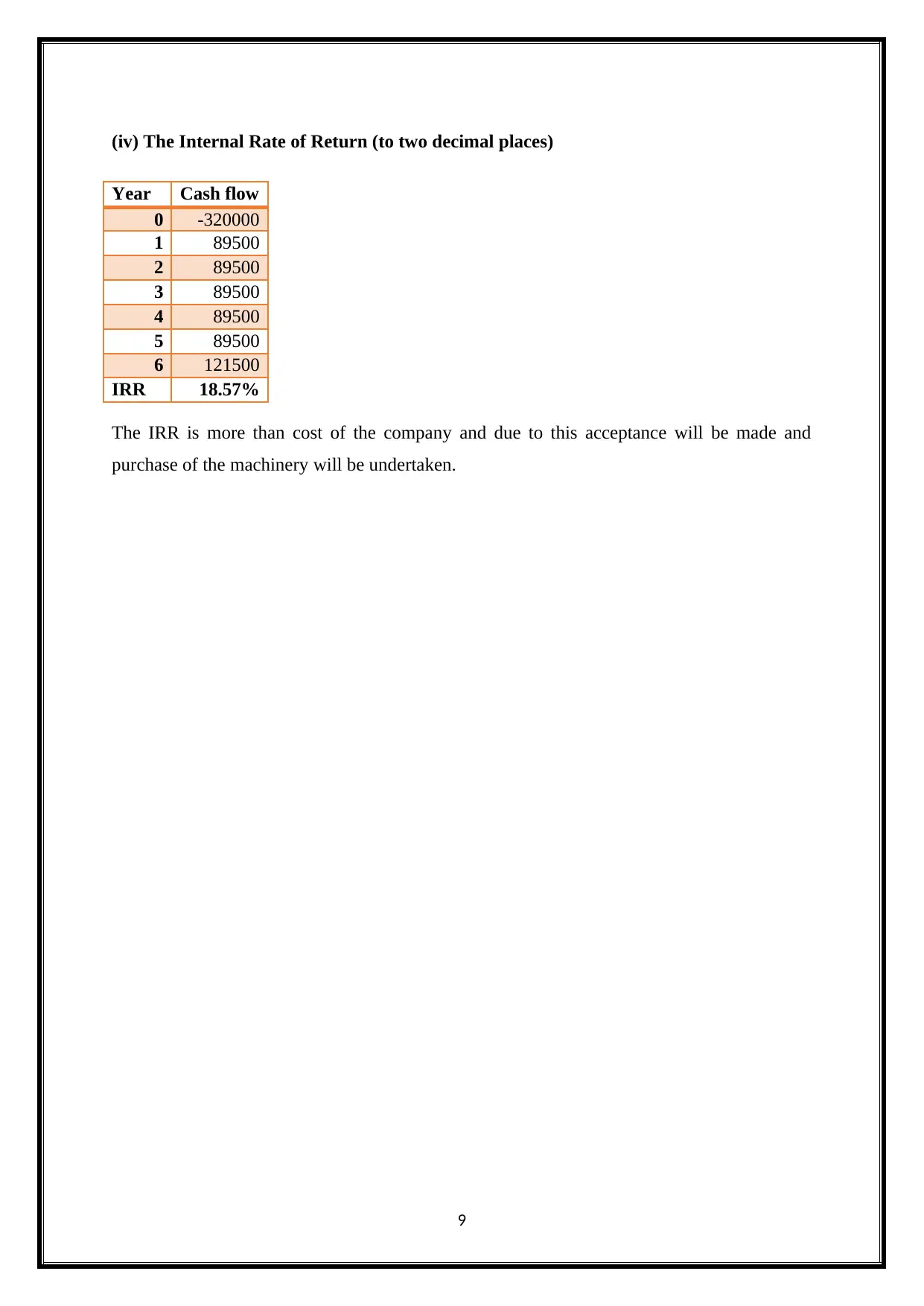
(iv) The Internal Rate of Return (to two decimal places)
Year Cash flow
0 -320000
1 89500
2 89500
3 89500
4 89500
5 89500
6 121500
IRR 18.57%
The IRR is more than cost of the company and due to this acceptance will be made and
purchase of the machinery will be undertaken.
9
Year Cash flow
0 -320000
1 89500
2 89500
3 89500
4 89500
5 89500
6 121500
IRR 18.57%
The IRR is more than cost of the company and due to this acceptance will be made and
purchase of the machinery will be undertaken.
9
⊘ This is a preview!⊘
Do you want full access?
Subscribe today to unlock all pages.

Trusted by 1+ million students worldwide
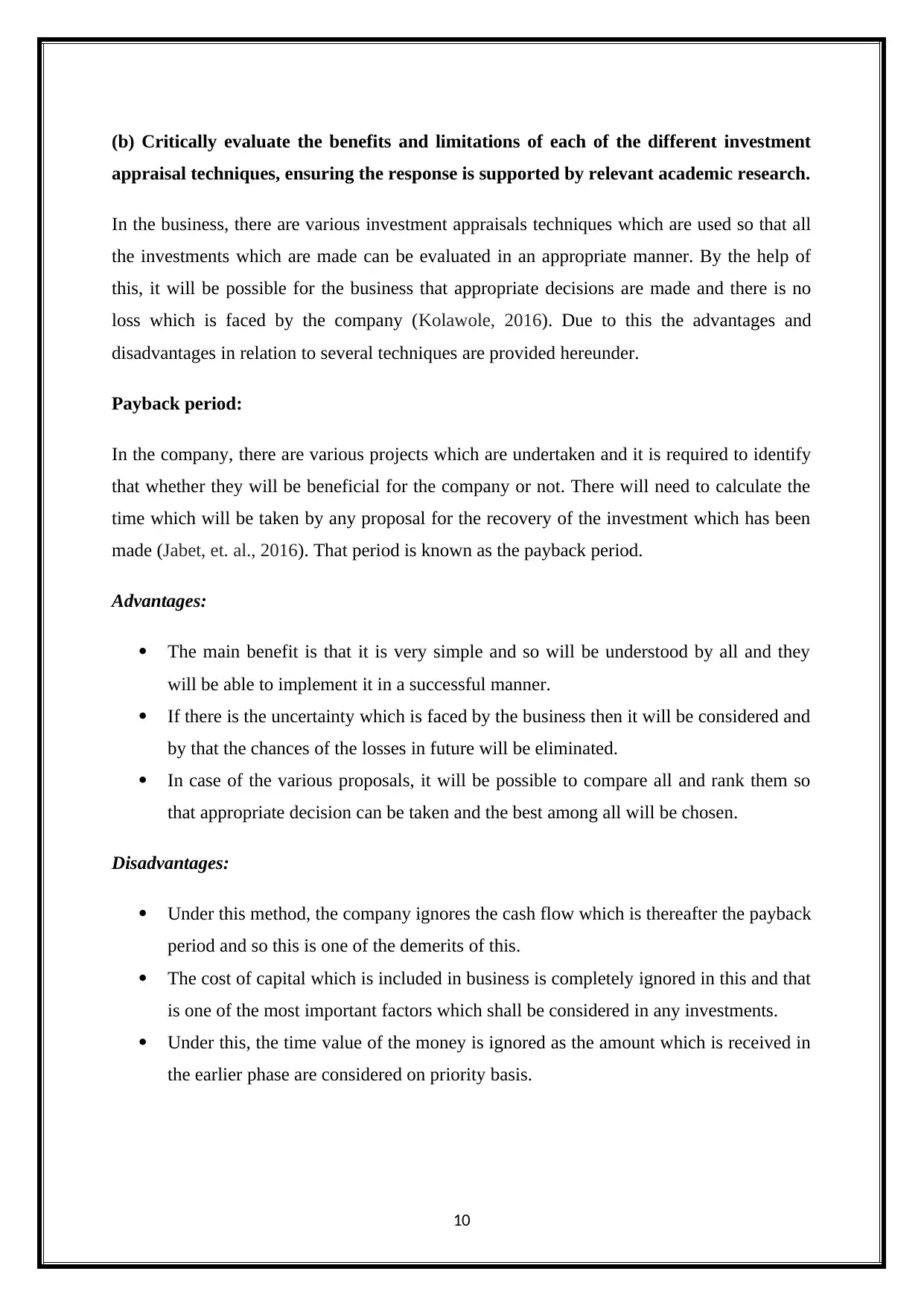
(b) Critically evaluate the benefits and limitations of each of the different investment
appraisal techniques, ensuring the response is supported by relevant academic research.
In the business, there are various investment appraisals techniques which are used so that all
the investments which are made can be evaluated in an appropriate manner. By the help of
this, it will be possible for the business that appropriate decisions are made and there is no
loss which is faced by the company (Kolawole, 2016). Due to this the advantages and
disadvantages in relation to several techniques are provided hereunder.
Payback period:
In the company, there are various projects which are undertaken and it is required to identify
that whether they will be beneficial for the company or not. There will need to calculate the
time which will be taken by any proposal for the recovery of the investment which has been
made (Jabet, et. al., 2016). That period is known as the payback period.
Advantages:
The main benefit is that it is very simple and so will be understood by all and they
will be able to implement it in a successful manner.
If there is the uncertainty which is faced by the business then it will be considered and
by that the chances of the losses in future will be eliminated.
In case of the various proposals, it will be possible to compare all and rank them so
that appropriate decision can be taken and the best among all will be chosen.
Disadvantages:
Under this method, the company ignores the cash flow which is thereafter the payback
period and so this is one of the demerits of this.
The cost of capital which is included in business is completely ignored in this and that
is one of the most important factors which shall be considered in any investments.
Under this, the time value of the money is ignored as the amount which is received in
the earlier phase are considered on priority basis.
10
appraisal techniques, ensuring the response is supported by relevant academic research.
In the business, there are various investment appraisals techniques which are used so that all
the investments which are made can be evaluated in an appropriate manner. By the help of
this, it will be possible for the business that appropriate decisions are made and there is no
loss which is faced by the company (Kolawole, 2016). Due to this the advantages and
disadvantages in relation to several techniques are provided hereunder.
Payback period:
In the company, there are various projects which are undertaken and it is required to identify
that whether they will be beneficial for the company or not. There will need to calculate the
time which will be taken by any proposal for the recovery of the investment which has been
made (Jabet, et. al., 2016). That period is known as the payback period.
Advantages:
The main benefit is that it is very simple and so will be understood by all and they
will be able to implement it in a successful manner.
If there is the uncertainty which is faced by the business then it will be considered and
by that the chances of the losses in future will be eliminated.
In case of the various proposals, it will be possible to compare all and rank them so
that appropriate decision can be taken and the best among all will be chosen.
Disadvantages:
Under this method, the company ignores the cash flow which is thereafter the payback
period and so this is one of the demerits of this.
The cost of capital which is included in business is completely ignored in this and that
is one of the most important factors which shall be considered in any investments.
Under this, the time value of the money is ignored as the amount which is received in
the earlier phase are considered on priority basis.
10
Paraphrase This Document
Need a fresh take? Get an instant paraphrase of this document with our AI Paraphraser
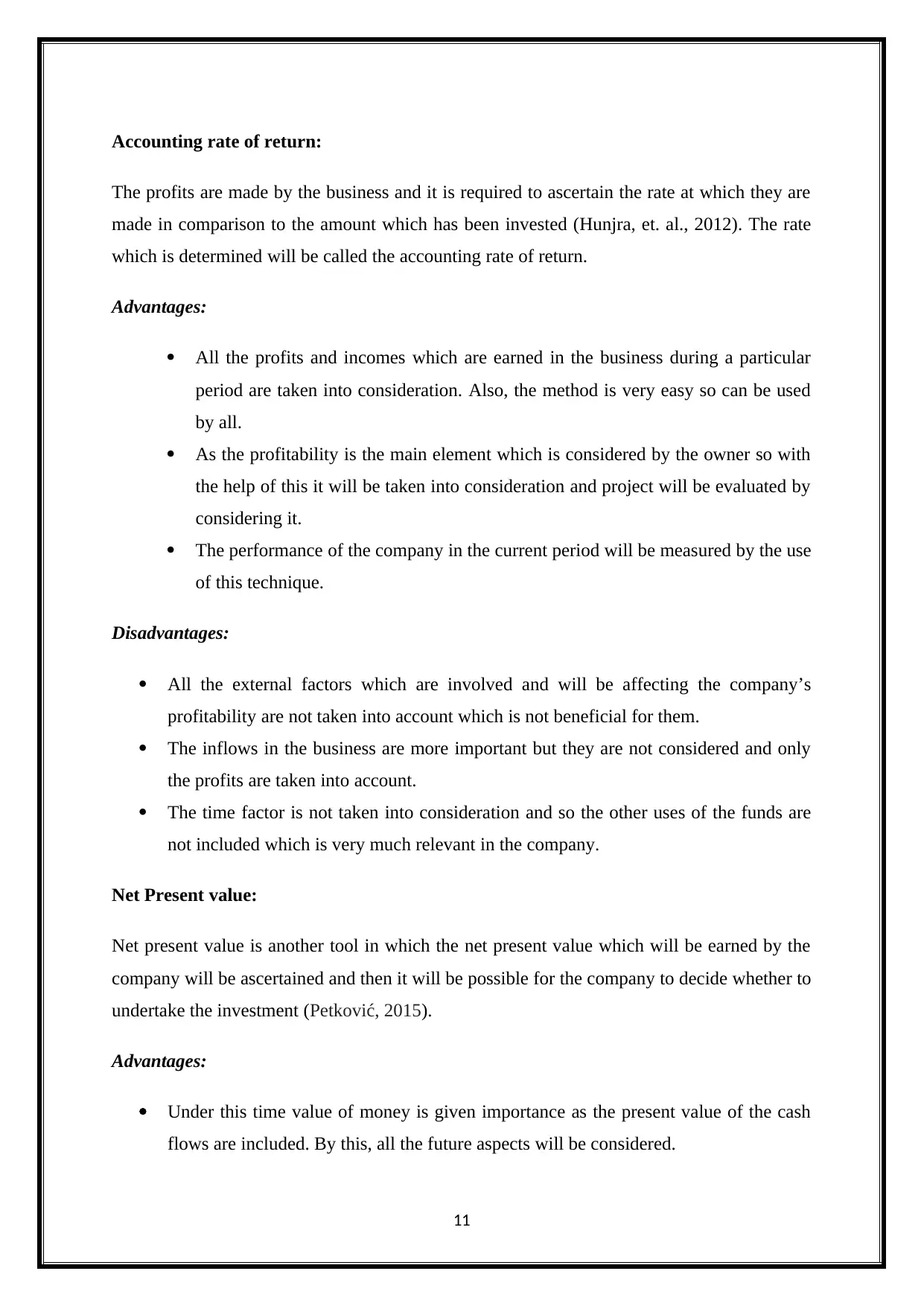
Accounting rate of return:
The profits are made by the business and it is required to ascertain the rate at which they are
made in comparison to the amount which has been invested (Hunjra, et. al., 2012). The rate
which is determined will be called the accounting rate of return.
Advantages:
All the profits and incomes which are earned in the business during a particular
period are taken into consideration. Also, the method is very easy so can be used
by all.
As the profitability is the main element which is considered by the owner so with
the help of this it will be taken into consideration and project will be evaluated by
considering it.
The performance of the company in the current period will be measured by the use
of this technique.
Disadvantages:
All the external factors which are involved and will be affecting the company’s
profitability are not taken into account which is not beneficial for them.
The inflows in the business are more important but they are not considered and only
the profits are taken into account.
The time factor is not taken into consideration and so the other uses of the funds are
not included which is very much relevant in the company.
Net Present value:
Net present value is another tool in which the net present value which will be earned by the
company will be ascertained and then it will be possible for the company to decide whether to
undertake the investment (Petković, 2015).
Advantages:
Under this time value of money is given importance as the present value of the cash
flows are included. By this, all the future aspects will be considered.
11
The profits are made by the business and it is required to ascertain the rate at which they are
made in comparison to the amount which has been invested (Hunjra, et. al., 2012). The rate
which is determined will be called the accounting rate of return.
Advantages:
All the profits and incomes which are earned in the business during a particular
period are taken into consideration. Also, the method is very easy so can be used
by all.
As the profitability is the main element which is considered by the owner so with
the help of this it will be taken into consideration and project will be evaluated by
considering it.
The performance of the company in the current period will be measured by the use
of this technique.
Disadvantages:
All the external factors which are involved and will be affecting the company’s
profitability are not taken into account which is not beneficial for them.
The inflows in the business are more important but they are not considered and only
the profits are taken into account.
The time factor is not taken into consideration and so the other uses of the funds are
not included which is very much relevant in the company.
Net Present value:
Net present value is another tool in which the net present value which will be earned by the
company will be ascertained and then it will be possible for the company to decide whether to
undertake the investment (Petković, 2015).
Advantages:
Under this time value of money is given importance as the present value of the cash
flows are included. By this, all the future aspects will be considered.
11

The profitability and risk which is involved in the business are taken into account
under this and by that, it will be possible to include them in advance so that they can
be dealt properly (Gotze, et. al., 2016).
By the use of this the value of the business is maximized.
Disadvantages:
The process which is involved in the calculation of this is complex and this makes it
difficult for all to use it. There will be skills which will be required to take this in use.
The discount rate will be required in the calculation of this and it is not easy to
ascertain that inappropriate manner. If the wrong discount rate is chosen then the
whole calculation will be a failure.
If the amount and the life of the several projects are not equal then, in that case, there
will be an improper decision which will be made and this affects the position of the
company.
The internal rate of return:
The internal rate of return is the rate at which the company will be in the situation where the
net present value is 0 (Weygandt, et. al., 2015). This shows that there will be neither the
profits nor the losses.
Advantages:
All the cash flows which are included in the project are given the equal amount of the
importance and by that, the proper results will be obtained so that they can be used in
making of the best decisions.
The profitability will be maintained as the point of the no loss and profit will be
identified which will be used in carrying out further operations in the required
manner.
The return which is made on the actual amount of investment is evaluated in this
which is very essential.
12
under this and by that, it will be possible to include them in advance so that they can
be dealt properly (Gotze, et. al., 2016).
By the use of this the value of the business is maximized.
Disadvantages:
The process which is involved in the calculation of this is complex and this makes it
difficult for all to use it. There will be skills which will be required to take this in use.
The discount rate will be required in the calculation of this and it is not easy to
ascertain that inappropriate manner. If the wrong discount rate is chosen then the
whole calculation will be a failure.
If the amount and the life of the several projects are not equal then, in that case, there
will be an improper decision which will be made and this affects the position of the
company.
The internal rate of return:
The internal rate of return is the rate at which the company will be in the situation where the
net present value is 0 (Weygandt, et. al., 2015). This shows that there will be neither the
profits nor the losses.
Advantages:
All the cash flows which are included in the project are given the equal amount of the
importance and by that, the proper results will be obtained so that they can be used in
making of the best decisions.
The profitability will be maintained as the point of the no loss and profit will be
identified which will be used in carrying out further operations in the required
manner.
The return which is made on the actual amount of investment is evaluated in this
which is very essential.
12
⊘ This is a preview!⊘
Do you want full access?
Subscribe today to unlock all pages.

Trusted by 1+ million students worldwide
1 out of 14
Related Documents
Your All-in-One AI-Powered Toolkit for Academic Success.
+13062052269
info@desklib.com
Available 24*7 on WhatsApp / Email
![[object Object]](/_next/static/media/star-bottom.7253800d.svg)
Unlock your academic potential
Copyright © 2020–2025 A2Z Services. All Rights Reserved. Developed and managed by ZUCOL.





